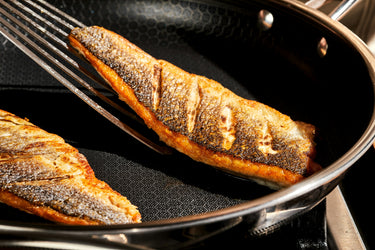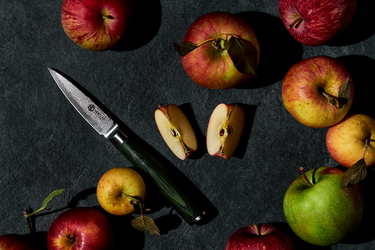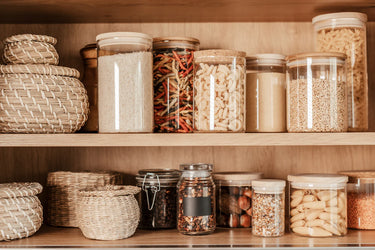Cooking at the Right Temperature

As much as we might all like to consider ourselves home cook aficionados, we all have areas where we can improve. Cooking at home can come with setbacks, especially when you’re learning new techniques or trying to perfect your cooking temperatures.
Luckily, using our HexClad cookware makes tricky feats simpler — and helps you master them in style.
The most fundamental skills are often the hardest to master, and cooking temperatures are no exception. We’ve all been there — you’re cooking meat, roasts, or chicken breast, and when you take it off the heat expecting it to be the perfect doneness, it’s raw.
We’ll kick off this article by explaining why cooking temperatures are so important. Spoiler alert: it’s about much more than not getting sick.
When we’re cooking, safety is always priority number one. After that, though, we also want to enjoy the food we prepare. Cooking temperature plays an integral part in almost every facet of cooking, which is why it’s such a crucial skill to get right.
We’ll also break down the tools and utensils you’ll need during the cooking process to ensure that your proteins are at the perfect internal temperature. This is how you take a great deal of the guesswork out of cooking, instead leaving you with an expertly prepared dish.
Why Is Cooking at Safe Temperatures So Important?
Cooking at the proper and safe temperatures is a critical component of cooking, whether professionally or at home. So, let’s talk about some food safety tips.
It’s reasonable to assume that the only reason to cook at safe temperatures is to ensure that germs and bacteria can’t grow on the food, but that’s only a piece of the puzzle.
Most of us (hopefully) know that different foods need to be served above specific temperatures in order to be safe to eat. However, people don’t always consider that many foods must also be kept under a certain temperature threshold to stay safe.
If you’re serving cold foods like fruits and salads, especially those with dairy or meat components, they need to be kept under 41 degrees. Otherwise, you run the risk of bacteria growing.
Meanwhile, hot foods, including soups and anything containing meat, need to be kept consistently above 135 degrees.
One Word: Bacteria
Nothing makes bacteria happier than food that’s between 41 to 135 degrees Fahrenheit. This range is known as the temperature danger zone since it provides bacteria with the perfect conditions to thrive and grow.
Just like us, bacteria need food to survive. By leaving food out to settle into the danger zone, you’re serving them up a buffet on a silver platter.
If your food isn’t cold enough, bacteria can grow. If your food isn’t kept hot enough, bacteria will grow. Basically, harmful bacteria and pathogens need not only a food source but also the right weather.
Take it from us, when the temperature is right (or wrong), bacteria will follow. And once your food is contaminated with bacteria, there’s no going back.
But are these bacteria really so bad? The short answer is yes, and the long answer is absolutely yes.
As bacteria grow, their growth will turn into foodborne illnesses. These illnesses can cause various symptoms, but the gist of it is always the same, and it’s gross.
When you eat bacteria-laden food, the bacteria settle into your stomach, making you sick. Your body then goes about dispelling said in all sorts of less-than-charming ways.
This horrible phenomenon is known as food poisoning, and anyone who’s ever had it knows it should be avoided at all costs. If you end up with something more serious than just food poisoning, you could be at risk for hospitalization.
This is caused by Salmonella — and not only is Salmonella liable to make you sick, but it is also responsible for 420 deaths a year.
Cooking Temp Affects Flavor, Too
Now that we covered the ins and outs of food poisoning, let’s get back to more pleasant topics.
When foods aren’t properly cooked, you’re likely to notice a problem with flavor as well. Steaks have a variety of internal temperatures that are safe to serve them at (rare, medium rare, medium, medium-well, and so on), but the flavor profile will be different with each temp.
Similarly, chicken will dry out the longer you cook it, which runs the risk of burning the spices on the exterior of the chicken. This creates charred flavors and bitter notes on the palette. As a result, overcooking leads to an unpleasant textural and flavor experience.
Your food can lack flavor at the other end of the spectrum, too. When your food is undercooked, flavor typically suffers.
Foods that aren’t brought up to the minimum internal temperature might not render the fats in meats well enough. If your spices and herbs don’t get enough heat, they won’t have the chance to become fragrant and round out the dish’s flavors.
In other words, your dish could end up completely bland no matter how much seasoning you swore you used.
What Tools Do You Need To Cook at the Right Temp?
To cook food correctly, you’ll need a few key items.
Utensils
First, you need the right utensils for flipping and stirring food in a pan. That means you need strong, durable metal utensils to hold onto your food and ensure that your dish isn’t ruined by thick, flimsy plastic.
Cookware
Next, you must ensure that you cook everything in the right pan. A chef is only as good as their tools, so you need pots and pans that are the best of the best.
That’s why you need HexClad. With HexClad, you can use all of those strong metal utensils for maximum control without worrying about the integrity of the pan.
And for delicate proteins like fish, this can make all the difference.
Our revolutionary hybrid pan provides a strong, durable cooking surface with an innovative aluminum core that conducts heat throughout the whole pan — except for the handles, thanks to our stay-cool handle technology.
When the pan heats evenly, not only will you save time in the kitchen, but you can ensure that all of your food is at the proper temperature. Without this capability, you could end up with certain areas in your protein that are safe… and others that aren’t.
Food Thermometer
You need to be sure about your food before you dig in. That’s why it’s worth it to invest in a durable, high-quality food thermometer. While the best cookware can ensure you get the heat you need to cook, you’ll still need to gauge the internal temp of your food often.
Once you get comfortable with knowing the temperature based on the sight and texture of the proteins, this becomes less of a necessity.
What Are Safe Cooking Temps for Meat and Poultry?
Now that you know why safe cooking temperatures are so crucial for food, let’s break down the different temps you need to get out for various proteins.
Below is our guide to different types of food and the temperature they need to reach to be safe.
Ground Meats
Ground meats and ground poultry need to be cooked to a temperature of 160 degrees Fahrenheit. This will ensure that the flavors are fully rounded out and that bacteria have been killed, making your food safe to eat.
You can generally gauge this by eye easier than with non-ground meat. Ground beef or turkey, for example, will change color significantly, browning and caramelizing as they cook.
Fresh Meat
Fresh meats, like cuts of steak, can vary a little depending on the internal temperature you prefer. Depending on what you like, you can serve certain cuts rare all the way through well-done.
As far as a minimum internal temperature goes, you need to bring your steaks up to 145 degrees Fahrenheit. Once you achieve this, you can decide where the sweet spot is for your taste buds.
This is different from tartare, as those types of raw meats are cured with acidic flavors. Most harmful bacteria cannot grow in acidic foods, which is why you’ll see restaurants use either lemon juice, vinegar, or even Worcestershire sauce as one of the dish’s components.
Poultry
Poultry requires the longest cooking time of all the most popular meats. With poultry, there’s no such thing as rare, medium, or well-done. If it’s rare, it’s raw, and if it’s “well-done,” it’s probably overcooked.
With poultry, it’s either done or it isn’t.
This can be confusing, often causing people to overcook poultry just to be safe.
For poultry, you want to achieve a temperature of 165 degrees Fahrenheit. You will need to insert the meat thermometer into the thickest part of the poultry to gauge the internal temperature accurately.
Once you reach 165, you can confidently remove it from the heat source.
Fish and Shellfish
Any type of fish or shellfish needs to reach an internal temperature of 145 degrees Fahrenheit to be edible. Like poultry, this protein can be easily overcooked. A clear indicator that your fish or shellfish is overdone is when white fats pool on top of it.
Instead, cook fish like salmon on the range with a high-quality non-stick pan and a metal fish spatula. This will create a better eye-line for you to monitor the cooking, so your cooking experience can be as thoughtful as your eating experience.
Egg Dishes
If you love a good omelet or casserole like Gordon Ramsay, you know how important a quality cook is for eggs.
You will need to reach 160 degrees Fahrenheit to achieve the perfect temp. It can be hard to gauge a proper temp on eggs with a thermometer, so a good rule of thumb is to achieve a firm texture across the egg whites and yolks before serving.
The Bottom Line on Cooking Temperatures
No matter how you grill it, cooking temperatures are not something to mess around with. Be careful and mindful to take temps often so you can get a better eye for what proteins should look like. This skill will come with time and is a sign that you’ve really stepped up your culinary prowess.
Have you ever woken up in a cold sweat from a nightmare of Gordon Ramsay screaming, “It’s raw!” in your face? After this guide, you can finally tell dream-Ramsay that you know exactly what you’re doing.
With HexClad on your side, we know you’ll get there in no time.
Sources:
Temperature and Time Requirements for Food | MN Dept of Health Food Business Safety
Tips to prevent bacteria from growing on your food | MSU Extension





